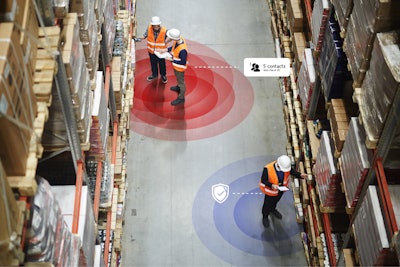
Improving organizational resilience starts from the ground level and requires organizations to look through a larger lens. At the start of 2021, 87% of supply chain professionals stated that they plan to invest in resilience in the next two years. While it’s important to have a forward-facing outlook and explore ways to improve supply chain resilience, it’s even more important to develop a shared understanding of what supply chain resilience looks like and identify the resources and approaches that will lead to these improvements. Before diving into the specific ways in which processes and operations can improve, supply chain leaders must check a few boxes to ensure they are working toward the proper goal. One of the main challenges that inhibits businesses from improving resilience of their supply chains is the inability to strategically identify the problem. Yes, leaders can see bottlenecks occurring in their supply chains but having a deeper understanding of where risks are acceptable and where they aren’t is key. With a unique knowledge of the organization, processes and management priorities, business continuity management professionals are well suited to aid supply chain leaders in developing context for these issues, including identifying high-level priorities.
Identifying areas of focus
As business continuity and resilience professionals, a core tenant of the job is to strategically understand an organization’s most important products and services, document how those are delivered to market and identify vulnerabilities in the process that could be exploited by threats. These concepts, when applied to supply chain resilience, can aid supply chain leaders in prioritizing their efforts. Regardless of how one refers to the process of identifying organizational priorities, understanding the most important things an organization provides to its customers is essential. Armed with this information, supply chain leaders can more appropriately answer fundamental questions like “What does supply chain resilience mean for the organization?” and demonstrate how improved resilience can lead to the continued delivery of those things that matter. Understanding this context is the first step in breaking down silos and making sure that leaders are working from the same list of priorities.
Creating a digital model of the business and determining single points of failure
Understanding where supply chain bottlenecks can occur then requires both an understanding of the end-to-end process required to bring a product to market and also analysis on where vulnerabilities exist. After setting high-level priorities, the next and somewhat cumbersome, activity is to build a digital model of the business to show how key products are sourced and delivered to market. This should include a clear understanding of where the organization operates, where the organization procures its goods and how value is added through manufacturing value chains or supply chains. Ultimately, organizations need to understand what is required to move a product from resource extraction, consolidation, manufacture and ultimately to the markets in which it is delivered. In a traditional BC approach, conducting a business impact analysis can help with this, however, this needs to be done in such a way that organizations identify critical paths and resources and vulnerabilities. End-to-end mapping (in a resiliency model) serves similar goals.
Each product or service being analyzed may require a different strategic direction to ultimately determine where potential faults lie. However, the commonality lies in observing each focus with a macro mindset. Take a look at how each piece of the puzzle fits together and what components should be examined more closely. For supply chain leaders, the end-to-end mapping approach needs to highlight single points of failure and downstream third parties that are essential in a product or service’s supply chain. At each point, study vulnerabilities to see which ones can be addressed and improved moving forward.
Click here to hear more about digital twins in the supply chain:
Generating plausible scenarios
Operational resilience highlights the need to generate extreme, yet plausible scenarios. To help in identifying and mitigating single points of failure, business continuity professionals can use findings to generate different types of scenarios that could potentially affect an organization’s supply chain, specifically looking at points where disruptions to single points of failure could halt the ability for resources or product to move to the next stage of the value chain. As these scenarios are prioritized for wargaming efforts, the organization can consider what happens if event A or B occurs, what are the steps taken to avoid major delays, reputational damage, or lost revenue? By taking a more proactive approach and generating potential scenarios before they happen, businesses can prepare accordingly and counteract potential disruptions that could cost both time and money.
Strategies may likely vary and may resemble the need to identify multiple suppliers for revenue-generating products in preparation for shifts in the market, as well as limit significant concentration of manufacturing in a given geographical location. Major disruptions that can dismantle organizational resilience within a supply chain include a pandemic, cyberattack, natural disaster and global shortages. These sometimes unexpected events have an ability to shine a light on companies’ lack of preparedness in putting systems in place that could have alleviated strain early on. In today’s world, businesses need third party support to deliver products and services, which expands capabilities but also increases risk, so the sooner businesses align their operations initiatives with resiliency tactics, the better.
Executing the solution
Solutions do not ignite change if supply chain leaders don’t incorporate them into their operations. End-to-end mapping, development of plausible scenarios and stress testing existing arrangements and third-party capabilities are a few ways businesses can move the needle and put strategies in place for the future. While solving supply chain issues is inherently difficult, improving operational resilience is the ultimate goal. Business continuity professionals have a range of tools and approaches that can help in making supply chains more resilient. By taking a look across the organization and thoughtfully analyzing vulnerabilities weaknesses, business continuity can help supply chain leaders connect to the broader organization and identify where additional contingencies are required in a more targeted way.
The reality of the current environment is that lean principles will likely continue to be the norm, even in the event of more widespread disruption. While operating lean may seem like a financially savvy approach, it may restrict the ability to counteract or bounce back from supply chain disruptions. Looking at any industry from pre-pandemic to where it stands now, the previously utilized “just-in-time” model is no longer always suitable to meet the new standard of operational resilience. Organizations must now augment the just-in-time model’ with a “just-in-case” mindset. Moving forward, executives are finding themselves looking at the big picture. Time, cost and support will always be main points of contention when evaluating operations. Not only do these elements affect profitability, but they also impact reputation amongst the industry and the customer. Lack of support and strategy can result in missteps that could have been avoidable, had the organization been more aware of weaknesses and proactive about improving them.
Ultimately by breaking down how a product or service is delivered, it’s easier to see how a business continuity management partner can assist in ensuring each step is done properly, leading to optimal resilience across an organization’s supply chain.


















![Pros To Know 2026 [color]](https://img.sdcexec.com/mindful/acbm/workspaces/default/uploads/2025/08/prostoknow-2026-color.mduFvhpgMk.png?ar=16%3A9&auto=format%2Ccompress&bg=fff&fill-color=fff&fit=fill&h=135&q=70&w=240)